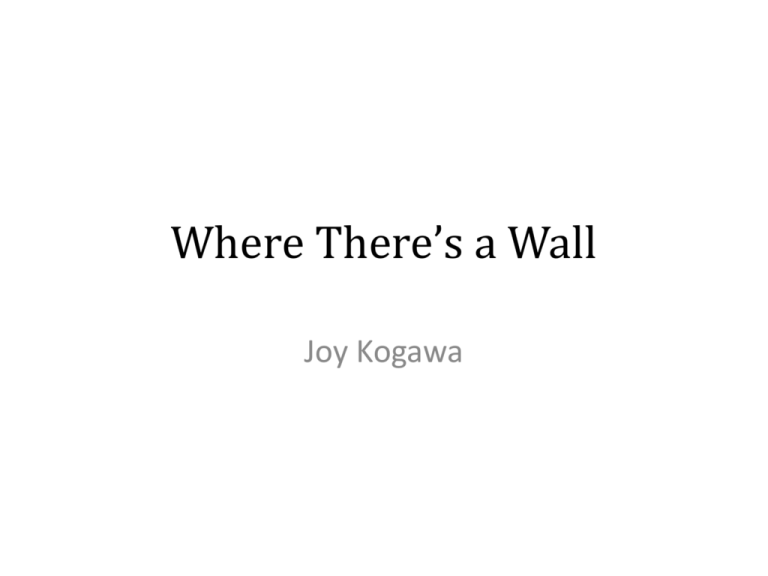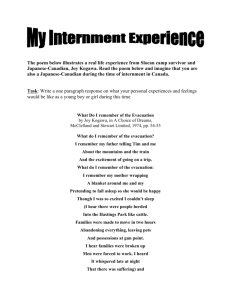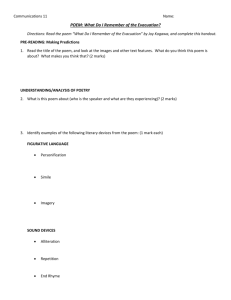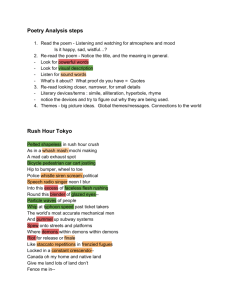Joy Kogawa Poetry Analysis: Walls, Evacuation, and Resilience
advertisement

Where There’s a Wall Joy Kogawa Joy Kogawa • Canadian of Japanese descent • Young girl growing up during WW2 – born 1935 • Sent to internment camps in Slocan Valley, BC and Coaldale, AB What do I Remember of the Evacuation? What do I remember of the evacuation? I remember my father telling Tim and me About the mountains and the train And the excitement of going on a trip. What do I remember of the evacuation? I remember my mother wrapping A blanket around me and my Pretending to fall asleep so she would be happy Although I was so excited I couldn't sleep (I hear there were people herded Into the Hastings Park like cattle. Families were made to move in two hours Abandoning everything, leaving pets And possessions at gun point. I hear families were broken up Men were forced to work. I heard It whispered late at night That there was suffering) and I missed my dolls. What do I remember of the evacuation? I remember Miss Foster and Miss Tucker Who still live in Vancouver And who did what they could And loved the children and who gave me A puzzle to play with on the train. And I remember the mountains and I was Six years old and I swear I saw a giant Gulliver of Gulliver's Travels scanning the horizon And when I told my mother she believed it too And I remember how careful my parents were Not to bruise us with bitterness And I remember the puzzle of Lorraine Life Who said "Don't insult me" when I Proudly wrote my name in Japanese And Tim flew the Union Jack When the war was over but Lorraine And her friends spat on us anyway and I prayed to the God who loves All the children in his sight That I might be white. Where There’s a Wall Where there’s a wall there’s a way through a gate or door. There’s even a ladder perhaps and a sentinel who sometimes sleeps. There are secret passwords you can overhear. There are methods of torture for extracting clues to maps of underground passages. There are zeppelins, helicopters, rockets, bombs, battering rams, armies with trumpets whose all at once blast shatters the foundations. Where there’s a wall there are words to whisper by loose bricks, wailing prayers to utter, birds to carry messages taped to their feet. There are letters to be written – poems even. Faint as in a dream is the voice that calls from the belly of the wall. Meaning 1. What is the theme of “Where There’s a Wall”? Refer to specific evidence from the poem to support your interpretation. 2. Analyze the significance of the poem’s title. Support your analysis with reference to the poem. Form and Style 3. Kogawa employs parallel structure and repetition of “Where there’s a wall” and “there’s” or “there are” in her poem. What might her purpose be in repeating “Where there’s a wall” only twice, while following these lines with seven phrases beginning with “there is” or “there are”? Barriers The human spirit has triumphed over barriers for many eras – consider the biblical, historical, and literary allusions • “Book of Joshua” in Old Testament, Chapter 6 – Joshua defeated Jericho without a battle • Wailing Wall (Western Wall) – a remnant of the wall of the second temple in Jerusalem; a place of pilgrimage, lamentation, and prayer • Berlin Wall – a wire and concrete barrier erected by the East German government in 1961 to separate the city of Berlin into East and West Berlin. East Germans trying to cross often lost their lives The wall was dismantled in 1989








